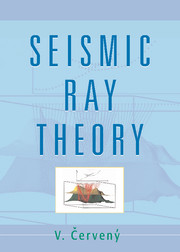Book contents
- Frontmatter
- Contents
- Preface
- 1 INTRODUCTION
- 2 THE ELASTODYNAMIC EQUATION AND ITS SIMPLE SOLUTIONS
- 3 SEISMIC RAYS AND TRAVEL TIMES
- 4 DYNAMIC RAY TRACING. PARAXIAL RAY METHODS
- 5 RAY AMPLITUDES
- 6 RAY SYNTHETIC SEISMOGRAMS
- APPENDIX A FOURIER TRANSFORM, HILBERT TRANSFORM, AND ANALYTICAL SIGNALS
- References
- Index
2 - THE ELASTODYNAMIC EQUATION AND ITS SIMPLE SOLUTIONS
Published online by Cambridge University Press: 03 February 2010
- Frontmatter
- Contents
- Preface
- 1 INTRODUCTION
- 2 THE ELASTODYNAMIC EQUATION AND ITS SIMPLE SOLUTIONS
- 3 SEISMIC RAYS AND TRAVEL TIMES
- 4 DYNAMIC RAY TRACING. PARAXIAL RAY METHODS
- 5 RAY AMPLITUDES
- 6 RAY SYNTHETIC SEISMOGRAMS
- APPENDIX A FOURIER TRANSFORM, HILBERT TRANSFORM, AND ANALYTICAL SIGNALS
- References
- Index
Summary
The seismic ray method is based on asymptotic high-frequency solutions of the elastodynamic equation. We assume that the reader is acquainted with linear elastodynamics and with the simple solutions of the elastodynamic equation in a homogeneous medium. For the reader's convenience, we shall briefly discuss all these topics in this chapter, particularly the plane-wave and point-source solutions of the elastodynamic equation. We shall introduce the terminology, notations, and all equations we shall need in the following chapters. In certain cases, we shall only summarize the equations without deriving them, mainly if such equations are known from generally available textbooks. This applies, for example, to the basic concepts of linear elastodynamics. In other cases, we shall present the main ideas of the solution, or even the complete derivation. This applies, for example, to the Green functions for acoustic, elastic isotropic and elastic anisotropic homogeneous media.
In addition to elastic waves in solid isotropic and anisotropic models, we shall also study pressure waves in fluid models. In this case, we shall speak of the acoustic case. There are two main reasons for studying the acoustic case. The first reason is tutorial. All the derivations for the acoustic case are very simple, clear, and comprehensible. In elastic media, the derivations are also simple in principle, but they are usually more cumbersome. Consequently, we shall mostly start the derivations with the acoustic case, and only then shall we discuss the elastic case. The second reason is more practical. Pressure waves in fluid models are often used as a simple approximation of P elastic waves in solid models. For example, this approximation is very common in seismic exploration for oil.
- Type
- Chapter
- Information
- Seismic Ray Theory , pp. 7 - 98Publisher: Cambridge University PressPrint publication year: 2001
- 1
- Cited by



